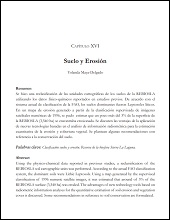| dc.contributor | Susan Gardner | |
| dc.creator | ITZEL SIFUENTES ROMERO | |
| dc.date | 2004-06-11 | |
| dc.identifier | http://cibnor.repositorioinstitucional.mx/jspui/handle/1001/374 | |
| dc.identifier.uri | http://dspace.cibnor.mx:8080/handle/123456789/2592 | |
| dc.description | Las siete tortugas marinas que existen en el mundo son consideradas amenazadas o en peligro de extinción, incluyendo a la tortuga prieta Chelonia mydas agassizii. Indudablemente ciertas actividades humanas como la sobre pesca y la pesca incidental han sido la causa de este colapso. En los últimos años ha incrementado la preocupación por ciertos productos químicos que son liberados al ambiente como pesticidas y detergentes. Estos compuestos conocidos como xenoestrógenos tienen la habilidad de mimetizar la acción de la hormona 17β-estradiol (E2). El impacto de estos contaminantes en el éxito reproductivo de la fauna silvestre es considerado crítico especialmente en organismos en peligro de extinción. La vitelogenina (VTG) es una proteína compleja que se sintetiza en todos los vertebrados ovíparos siendo los estrógenos el principal estímulo para su síntesis y secreción. Esta producción esta normalmente restringida a hembras adultas, sin embargo, su síntesis puede ser inducida en machos y hembras inmaduras por la exposición a xenoestrógenos, características que hacen de esta proteína un biomarcador ideal. El presente trabajo reporta la caracterización de VTG de C. mydas agassizzi y la subsecuente validación de un ensayo inmunoenzimático (ELISA) para su detección en plasma. La VTG se purificó de plasma de machos inducidos con E2 por medio de cromatografía de intercambio iónico. La proteína aislada, ausente en el plasma de macho antes de la inducción (control), se identificó como VTG por su naturaleza glico-lipo-proteica y por la homología de su secuencia de aminoácidos con VTG de otros vertebrados. Se caracterizó como un dímero de aproximadamente 500 kDa compuesto de dos monómeros de igual peso molecular de aproximadamente 200 kDa. La VTG purificada se utilizó como antígeno en la elaboración de anticuerpos policlonales cuyo alto título y especificidad se comprobó por ELISA y Western blot respectivamente. La sensibilidad del ELISA desarrollado se estimó entre 15 ng/ml y 2 µg/ml, el coeficiente de variación entre y dentro del ensayo fue menor al 8 y 10%, respectivamente, indicando su precisión. Se encontró paralelismo entre la curva estándar y las curvas generadas con diluciones de plasma inducido, además se determinó 1:5000, como la dilución en la que el efecto matriz se reduce [...] | |
| dc.description | The seven sea turtle species that exist worldwide are considered either threatened or endangered including the black turtle, Chelonia mydas agassizii. Certainly, human interference like over fishing and incidental catch are the cause of this collapse. In the past years there has been an increasing concern about several chemical products released into the environment, including pesticides and detergents. These compounds known as xenoestrogens, have the potential to mimic the action of the steroid hormone 17ß-estradiol. The impact of these common pollutants on the reproductive success of wildlife may be considerable especially in endangered species such as the black turtle. Vitellogenin (VTG) is a complex protein that is produce in the liver in response to estrogen stimulation in oviparous vertebrates. It is normally found in adult females during egg production and absent in males and juveniles. However, juveniles and males can produce VTG in response to xenoestrogens. Therefore VTG, may be useful as a biomarker of exposure to estrogenic compounds. This thesis reports the purification and characterization of C. mydas agassizii VTG with the subsequent development of a specific ELISA for VTG measurement in turtle plasma. Plasmatic VTG was purified from E2-induced males using ion exchange chromatography. The isolated protein, absent in male turtle plasma before induction, was identified as VTG by its glico-lipo-protein nature and its homology with other vertebrate VTG amino acid sequence. It was characterized as a 500 kDa dimer composed by two 200 kDa monomers. The purified protein was used as antigen for polyclonal antibody production. The high titer and specificity was proven with ELISA and Western blotting, respectively. The sensitivity of the assay was estimated between 15 ng/ml and 2 µg/ml, inter and intra-assay coefficients of variation were less than 8 and 10%, respectively, indicating its precision. Plasma dilution curves from E2 induced male turtle showed parallelism with the standard curve. Matrix effect was reduced at dilution 1:5000 [...] | |
| dc.format | application/pdf | |
| dc.language | spa | |
| dc.publisher | Centro de Investigaciones Biológicas del Noroeste, S.C. | |
| dc.rights | info:eu-repo/semantics/openAccess | |
| dc.rights | http://creativecommons.org/licenses/by-nc-nd/4.0 | |
| dc.subject | info:eu-repo/classification/AUTOR/Vitelogenina; Chelonia mydas agassizii; biomarcador; xenoestrógenos; ELISA | |
| dc.subject | info:eu-repo/classification/cti/2 | |
| dc.subject | info:eu-repo/classification/cti/24 | |
| dc.subject | info:eu-repo/classification/cti/2401 | |
| dc.subject | info:eu-repo/classification/cti/240119 | |
| dc.subject | info:eu-repo/classification/cti/240119 | |
| dc.title | Caracterización parcial de vitelogenina de Chelonia mydas agassizii y validación de un ensayo inmunoenzimático (elisa) para su detección en plasma como potencial biomarcador de xenoestrógenos | |
| dc.type | info:eu-repo/semantics/masterThesis | |

